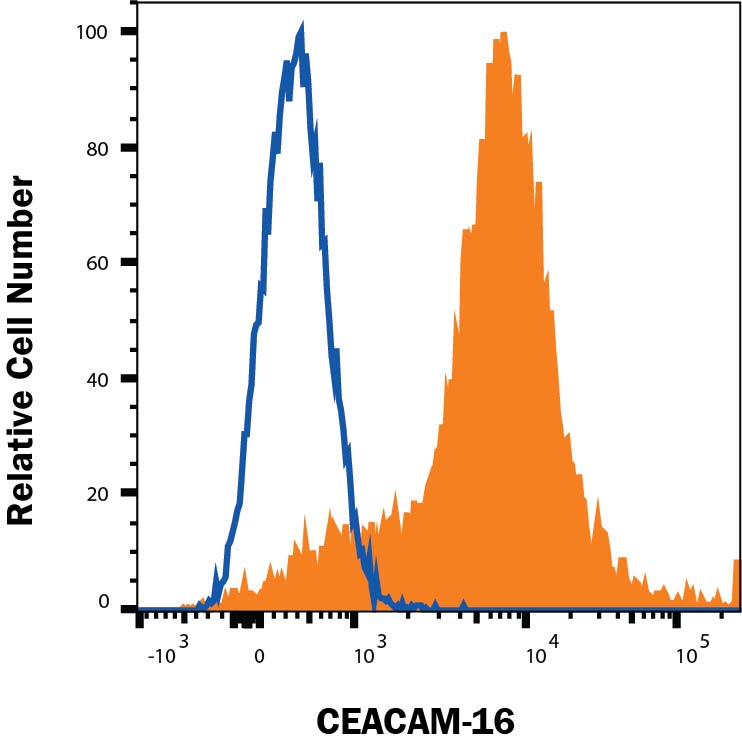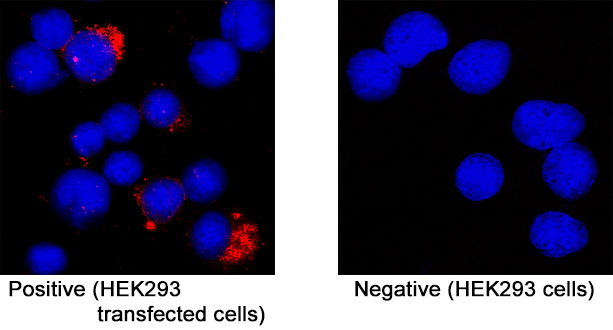Human CEACAM-16 Antibody Summary
Met1-Gly425
Accession # Q2WEN9
Applications
Please Note: Optimal dilutions should be determined by each laboratory for each application. General Protocols are available in the Technical Information section on our website.
Scientific Data
 View Larger
View Larger
Detection of CEACAM-16 in HEK293 Human Cell Line Transfected with Human CEACAM-16 by Flow Cytometry HEK293 human embryonic kidney cell line transfected with human CEACAM-16 (filled histogram) or irrelevant protein (open histogram) was stained with Rabbit Anti-Human CEACAM-16 Monoclonal Antibody (Catalog # MAB9885) followed by Allophycocyanin-conjugated Anti-Rabbit IgG Secondary Antibody (F0111). Quadrant markers were set based on control antibody staining (MAB1050). Staining was performed using our Staining Membrane-associated Proteins protocol.
 View Larger
View Larger
CEACAM-16 in HEK293 Human Cell Line. CEACAM-16 was detected in immersion fixed HEK293 human embryonic kidney cell line transfected (positive staining) and HEK293 human embryonic kidney cell line (non-transfected, negative staining) using Rabbit Anti-Human CEACAM-16 Monoclonal Antibody (Catalog # MAB9885) at 3 µg/mL for 3 hours at room temperature. Cells were stained using the NorthernLights™ 557-conjugated Anti-Rabbit IgG Secondary Antibody (red; NL004) and counterstained with DAPI (blue). Specific staining was localized to cytoplasm. Staining was performed using our protocol for Fluorescent ICC Staining of Non-adherent Cells.
Reconstitution Calculator
Preparation and Storage
- 12 months from date of receipt, -20 to -70 °C as supplied.
- 1 month, 2 to 8 °C under sterile conditions after reconstitution.
- 6 months, -20 to -70 °C under sterile conditions after reconstitution.
Background: CEACAM-16
Carcinoembryonic Antigen-related Cell Adhesion Molecule 16 (CEACAM-16), or CEAL2, is part of the CEA protein family consisting of CEACAMs and the pregnancy‑specific glycoproteins (PSGs). Both CEACAM and PSG molecules have been identified in humans and belong to the much larger glycosylphosphatidylinositol (GPI)-linked immunoglobulin (Ig) superfamily (1, 2). Unique to the CEA family, CEACAM-16 is a secreted molecule lacking a recognizable transmembrane domain or GPI anchor (3). Mature human CEACAM-16 is 405 amino acids (aa), containing 2 IgC2-like domains and 2 IgV-like domains. CEACAM-16 is one of only five conserved CEACAMs among mice, rats, and humans (2). Mature human CEACAM-16 shares 90% and 89% aa identity with mouse and rat CEACAM‑16, respectively. Originally discovered as a biomarker for colorectal cancer (4), CEACAMs have now been associated with numerous intracellular signaling processes including cell adhesion, cell growth, recognition and differentiation, angiogenesis, and apoptosis (5-7). CEACAM-16 is specifically expressed in the inner ear and has been shown to play a critical role in hearing. CEACAM-16 has been identified as a binding partner for alpha tectorin and specific mutations in CEACAM-16 have been linked to autosomal dominant nonsyndromic deafness (ADNSHL) (3, 8).
- Beauchemin, N. et al. (1999) Exp. Cell Res. 252:243.
- Zebhauser R. et al. (2005) Genomics 86:566.
- Zheng, J. et al. (2011) PNAS. 108(10):4218.
- Gold P. and Freedman S.O. (1965) J Exp Med 122:467.
- Obrink, B. (1997) Curr Opin Cell Biol 9:616.
- Horst, A.K. and Wagener, C. (2004) Handb Exp Pharmacol 283.
- Kuespert K et al. (2006) Curr Opin Cell Biol. 18(5):565.
- Wang, H. et al. (2015) J Hum Genet. 60(3):119.
Product Datasheets
FAQs
No product specific FAQs exist for this product, however you may
View all Antibody FAQsReviews for Human CEACAM-16 Antibody
There are currently no reviews for this product. Be the first to review Human CEACAM-16 Antibody and earn rewards!
Have you used Human CEACAM-16 Antibody?
Submit a review and receive an Amazon gift card.
$25/€18/£15/$25CAN/¥75 Yuan/¥2500 Yen for a review with an image
$10/€7/£6/$10 CAD/¥70 Yuan/¥1110 Yen for a review without an image

